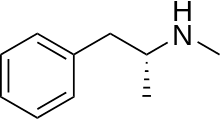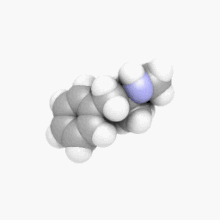Levomethamphetamine
Levomethamphetamine[note 1] is the levorotatory (L-enantiomer) form of methamphetamine. Levomethamphetamine is a sympathomimetic vasoconstrictor which is the active ingredient in some over-the-counter (OTC) nasal decongestant inhalers in the United States.[note 2]
 | |
 | |
| Clinical data | |
|---|---|
| Routes of administration | Medical: Inhalation (nasal) Recreational: Oral, intravenous, insufflation, inhalation, suppository |
| Legal status | |
| Legal status |
|
| Pharmacokinetic data | |
| Metabolism | Hepatic |
| Excretion | Renal |
| Identifiers | |
IUPAC name
| |
| CAS Number | |
| PubChem CID | |
| ChemSpider | |
| UNII | |
| KEGG | |
| CompTox Dashboard (EPA) | |
| ECHA InfoCard | 100.046.974 |
| Chemical and physical data | |
| Formula | C10H15N |
| Molar mass | 149.23 g·mol−1 |
| 3D model (JSmol) | |
SMILES
| |
InChI
| |
| | |
Pharmacology
Levomethamphetamine crosses the blood-brain-barrier and acts as a TAAR1 agonist,[3] functioning as a selective norepinephrine releasing agent (with few or no effects on the release of dopamine), so it affects the central nervous system, although its effects are qualitatively distinct relative to those of dextromethamphetamine.[4] It does not possess the potential for euphoria or addiction that dextromethamphetamine possesses.[4][5][6] Among its physiological effects are the vasoconstriction that makes it useful for nasal decongestion.[7] The elimination half-life of levomethamphetamine is between 13.3 and 15 hours, whereas dextromethamphetamine has a half-life of about 10.5 hours.[8]
Selegiline
Levomethamphetamine is the active metabolite of the antiparkinson's drug selegiline.[9] Selegiline, a selective monoamine oxidase B (MAOB) inhibitor at low doses,[note 3] is also metabolized into levomethamphetamine and levoamphetamine.[10][11] This has caused users to test positive for amphetamines.[12][13]
Selegiline itself has neuroprotective and neuro-rescuing effects, but concern over the resulting levomethamphetamine's neurotoxicity led to development of alternative MAOB inhibitors such as rasagiline, that do not produce toxic metabolites.[14][15]
Side effects
When the nasal decongestant is taken in excess, levomethamphetamine has potential side effects resembling those of other sympathomimetic drugs; these effects include hypertension (elevated blood pressure), tachycardia (rapid heart rate), nausea, stomach cramps, dizziness, headache, sweating, muscle tension, and tremors. Central side effects may include anxiety, insomnia, and anorexia (loss of appetite).
Non-medicinal usage
In a study of psychoactive effects of levomethamphetamine, the intravenous administration of 0.5 mg/kg (but not 0.25 mg/kg) in recreational methamphetamine users produced scores of "drug liking" similar to racemic methamphetamine, but the effects were shorter lived. The study did not test the oral administration of levomethamphetamine. Currently there are no studies demonstrating "drug liking" scores of oral levomethamphetamine that are similar to racemic methamphetamine or dextromethamphetamine in either recreational users or medicinal users.[5]
Detection in body fluids
Levomethamphetamine can register on urine drug screens as either methamphetamine, amphetamine, or both, depending on the subject's metabolism and dosage. L-methamphetamine metabolizes completely into L-amphetamine after a period of time.[16]
Notes
- Other names include l-methamphetamine, levodesoxyephedrine, l-desoxyephedrine, levmetamfetamine (INN and USAN).
- The active ingredient in some OTC inhalers in the United States is listed as levmetamfetamine, the INN and USAN of levomethamphetamine.[1][2]
- It is a selective MAOB inhibitor at normal clinical doses. MAOB is an enzyme that metabolizes dopamine, the neurotransmitter deficient in Parkinson's Syndrome.
References
- "CFR TITLE 21: DRUGS FOR HUMAN USE: PART 341 -- COLD, COUGH, ALLERGY, BRONCHODILATOR, AND ANTIASTHMATIC DRUG PRODUCTS FOR OVER-THE-COUNTER HUMAN USE". United States Food and Drug Administration. April 2015. Archived from the original on 18 September 2015. Retrieved 7 March 2016.
Topical nasal decongestants --(i) For products containing levmetamfetamine identified in 341.20(b)(1) when used in an inhalant dosage form. The product delivers in each 800 milliliters of air 0.04 to 0.150 milligrams of levmetamfetamine.
- "Identification". Levomethamphetamine. Pubchem Compound. National Center for Biotechnology Information. Retrieved 2 January 2014.
- "Classification". Levmetamfetamine. PubChem Compound. NCBI. Archived from the original on 18 October 2014. Retrieved 17 October 2014.
- Melega, WP; Cho, AK; Schmitz, D; Kuczenski, R; Segal, DS (February 1999). "l-methamphetamine pharmacokinetics and pharmacodynamics for assessment of in vivo deprenyl-derived l-methamphetamine". The Journal of Pharmacology and Experimental Therapeutics. 288 (2): 752–8. PMID 9918585.
- Mendelson J, Uemura N, Harris D, Nath RP, Fernandez E, Jacob P, Everhart ET, Jones RT (October 2006). "Human pharmacology of the methamphetamine stereoisomers". Clinical Pharmacology and Therapeutics. 80 (4): 403–20. doi:10.1016/j.clpt.2006.06.013. PMID 17015058.
- Kuczenski, R; Segal, DS; Cho, AK; Melega, W (February 1995). "Hippocampus norepinephrine, caudate dopamine and serotonin, and behavioral responses to the stereoisomers of amphetamine and methamphetamine". The Journal of Neuroscience. 15 (2): 1308–17. doi:10.1523/jneurosci.15-02-01308.1995. PMID 7869099.
- Pray SW. "Nonprescription Products to Avoid With Hypertension". uspharmacist.com. Archived from the original on 30 October 2014. Retrieved 17 October 2014.
Topical Nasal Decongestants
Most topical nasal decongestants also carry the warning against unsupervised use with hypertension. This includes oxymetazoline (e.g., Afrin), phenylephrine (e.g., Neo-Synephrine), naphazoline (e.g., Privine), and l-desoxyephedrine/levmetamfetamine. When hypertensive patients request a nasal decongestant, the pharmacist can recommend several alternatives. Propylhexedrine (e.g., Benzedrex Inhaler) is not required to carry a warning against unsupervised use with hypertension and may be effective. Another option is the nasal strip (e.g., Breathe Right). When properly applied, the strip can open the nostrils slightly, and perhaps sufficiently to allow the patient to breathe without use of a pharmacologically active ingredient. - Mendelson J, Uemura N, Harris D, et al. (October 2006). "Human pharmacology of the methamphetamine stereoisomers". Clin. Pharmacol. Ther. 80 (4): 403–20. doi:10.1016/j.clpt.2006.06.013. PMID 17015058.
- Method for the production of selegiline hydrochloride., archived from the original on 1 November 2018, retrieved 4 October 2015
- Kalász, H.; Magyar, K.; Szőke, É; Adeghate, E.; Adem, A.; Hasan, M. Y.; Nurulain, S. M.; Tekes, K. (1 January 2014). "Metabolism of selegiline [(-)-deprenyl)]". Current Medicinal Chemistry. 21 (13): 1522–1530. doi:10.2174/0929867321666131218094352. ISSN 1875-533X. PMID 24350849.
- Magyar, Kálmán (1 January 2011). "The pharmacology of selegiline". International Review of Neurobiology. 100: 65–84. doi:10.1016/B978-0-12-386467-3.00004-2. ISSN 0074-7742. PMID 21971003.
- Cody, J. D. (1 December 1993). "Metabolic Precursors to Amphetamine and Methamphetamine". Forensic Science Review. 5 (2): 109–127. ISSN 1042-7201. PMID 26270078.
- Cody, John T. (1 May 2002). "Precursor medications as a source of methamphetamine and/or amphetamine positive drug testing results". Journal of Occupational and Environmental Medicine. 44 (5): 435–450. doi:10.1097/00043764-200205000-00012. ISSN 1076-2752. PMID 12024689.
- Tabakman R, Lecht S, Lazarovici P (2004). "Neuroprotection by monoamine oxidase B inhibitors: a therapeutic strategy for Parkinson's disease?". BioEssays. 26 (1): 80–90. doi:10.1002/bies.10378. PMID 14696044.
- Kong, Ping; Zhang, Benshu; Lei, Ping; Kong, Xiaodong; Zhang, Shishuang; Li, Dai; Zhang, Yun (1 January 2015). "Neuroprotection of MAO-B inhibitor and dopamine agonist in Parkinson disease". International Journal of Clinical and Experimental Medicine. 8 (1): 431–439. ISSN 1940-5901. PMC 4358469. PMID 25785014.
- "Methamphetamine Urine Toxicology: An In-depth Review". Practical Pain Management. Archived from the original on 13 February 2016. Retrieved 21 February 2016.